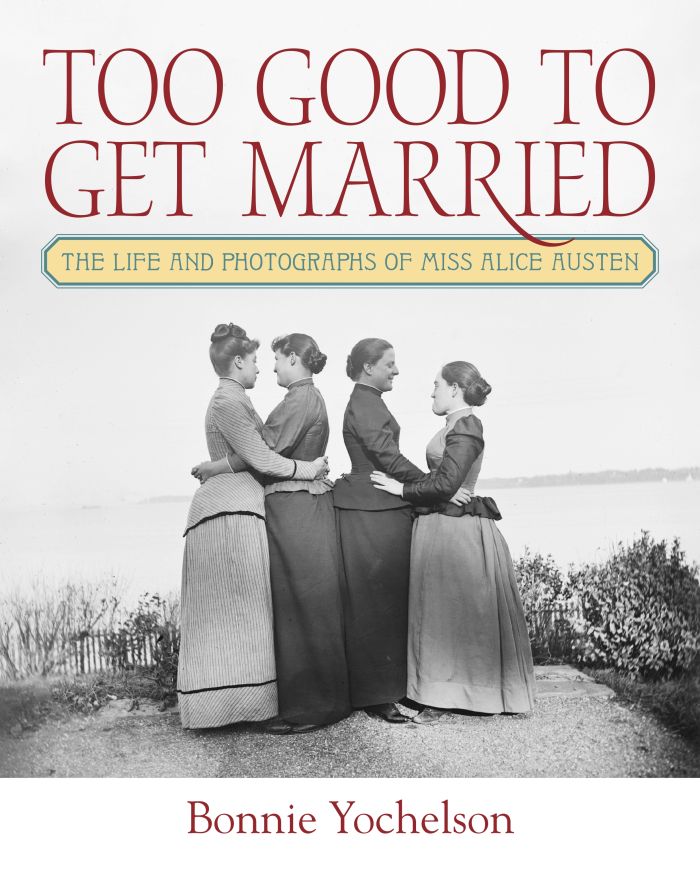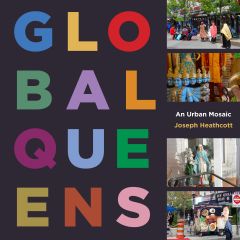Save 25% plus free shipping during our Winter Sale! Use promo code JOY2025. Expires 1/5/26.
Too Good to Get Married
The Life and Photographs of Miss Alice Austen

This book can be opened with

Explore Gilded Age New York through the lens of Alice Austen, who captured the social rituals of New York’s leisured class and the bustling streets of the modern city. Celebrated as a queer artist, she was this and much more
Alice Austen (1866–1952) lived at Clear Comfort, her grandparent’s Victorian cottage on Staten Island, which is now a National Historic Landmark. As a teenager, she devoted herself to photography, recording what she called “the larky life” of tennis matches, yacht races, and lavish parties.
When she was 25 and expected to marry, Austen used her camera to satirize gender norms by posing with her friends in their undergarments and in men’s clothes, “smoking” cigarettes, and feigning drunkenness. As she later remarked, she was “too good to get married.” Austen embraced the rebellious spirit of the “New Woman,” a moniker given to those who defied expectations by pursuing athletics, higher education, or careers. She had romantic affairs with women, and at 31, she met Gertrude Tate, who became her life partner. Briefly, Austen considered becoming a professional photographer. She illustrated Bicycling for Ladies, a guide written by her friend Violet Ward, and she explored the working-class neighborhoods of Manhattan to produce a portfolio, “Street Types of New York.” Rejecting the taint of commerce, however, she remained within the confines of elite society with Tate by her side.
Although interest in Austen has accelerated since 2017, when the Alice Austen House was designated a national site of LGBTQ history, the only prior book on Austen was published in 1976. Copiously illustrated, Too Good to Get Married fills the need for a fresh and deeply researched look at this skillful and witty photographer. Through analysis of Austen’s photographs, Yochelson illuminates the history of American photography and the history of sexuality.
The first major biography of Alice Austen to appear in nearly fifty years. Yochelson offers a new and compelling appraisal of this significant woman photographer of the late 19th and early 20th centuries, integrating Austen’s intimate woman-centered life with her evolving photography.—Kathy Peiss, Roy F. and Jeannette P. Nichols Professor Emerita of American History at the University of Pennsylvania
An engaging, lively, and insightful look at the life and work of photographer Alice Austen, a pioneering figure in women’s and lesbian history whose story has not been well-told until now. Yochelson carefully and thoughtfully assesses Austen’s life as a moving and revealing lens on the place of women in the United States and New York in a period of dramatic change.—Stephen Vider, author of The Queerness of Home: Gender, Sexuality, and the Politics of Domesticity After World War II
Much of photohistory—and the photography discourse during Alice Austen’s time—is preoccupied with photography’s artistic status and its evolving documentary capacities. Yochelson posits a different concern: photography as social currency. This engaging biography is also an incisive social history, ranging from the Gilded Age to feminism. The protagonists and the period come to life vividly as a result of extensive primary research, while Yochelson also encourages the reader to think about what went unspoken: views that were simply assumed to be shared by all, or feelings for which direct language didn’t exist.—Britt Salvesen, Curator and Head, Wallis Annenberg Photography Department, Los Angeles County Museum of Art
Finally! After seventy-five years in relative obscurity, we have a genuine biographical study of this pioneering, elusive woman. Alice Austen was a brilliant early photographer, whose name ought to be well-known. She led a generally cloistered, privileged life on Staten Island, until her tragic end. But she produced a huge body of innovative, experimental work that now at last is getting the attention it deserves. And in these pages we find the complex person behind it, a modern-day lesbian icon who carried all the usual prejudices of the industrial era aristocracy. You can find no better guide for the life and work of Miss Austen.—Peter-Christian Aigner, Director, The Gotham Center for New York City History
Bonnie Yochelson traces the extraordinary story of how a 19th-century upper-class social butterfly became a pioneering woman photographer who lived most of her life in a loving lesbian partnership. Alice Austen, with all her complexities and remarkable talent, comes alive in these engaging pages. Too Good to Get Married is a wonderful read.—Lillian Faderman, author of Odd Girls and Twilight Lovers: A History of Lesbian Life in 20th-Century America
Yochelson, former curator of prints and photographs at the Museum of the City of New York, pays homage to photographer Alice Austen (1866-1952), who, like Jacob Riis and Lewis Hine, documented a changing America. . . Generously illustrated, the biography reveals a change in her perspective in 1891 when she began to use her camera to satirize social rituals and gender politics—posing herself and friends dressed in men’s clothes, for example. . . A sensitive portrait of a prolific photographer.—Kirkus Reviews
Too Good to Get Married is an assiduous, revealing biography of a complex early feminist photographer who carved her own path.—Foreword Reviews
In Bonnie Yochelson’s copiously illustrated, extensively researched, and highly entertaining biography, ‘Too Good to Get Married: The Life and Photographs of Miss Alice Austen’ (Fordham University Press / Empire State Editions); she describes how a woman who grew up in the Gilded Age, when the term 'lesbian' did not yet exist, challenged and conformed to the conservative ideals of Staten Island high society.—The Eye of Photography
Standing on the edge of the Staten Island property where photographer Alice Austen lived for the vast majority of her life and looking out as gargantuan container ships and massive cruise ships make their way under the soaring metal span of the Verrazano Bridge, and into the protected waters of New York Harbor, you get some sense of the worlds that passed before her doorstep. You are also reminded of the relative isolation of her Staten Island, a place that, for much of Austen’s early life in the late 1800s, was an enclave for the wealthy. Her relatively bohemian home base allowed her to establish an unconventional life that provided the content for her riveting photographs of friends and lovers, offering a tantalizing and exceedingly rare visual record of one woman’s lesbian existence starting in the late 19th century. But Austen’s desire to remain mostly detached from the realities facing other New Yorkers at a time of enormous social and cultural upheaval makes her view highly specific. That said, Austen’s life and these images continue to have an impact, and this new, much more complete biography offers a better image of her than we’ve ever had before.—Hyperallergic
TOO GOOD TO GET MARRIED: The Life and Photographs of Miss Alice Austen by historian Bonnie Yochelson is a singular work of impressive historical research and with a meticulous attention to detail. Deftly written, profusely illustrated with B/W historical photos, exceptionally informed and informative...A fascinating read from start to finish.—Midwest Book Review
Bonnie Yochelson is a former Curator of Prints and Photographs at the Museum of the City of New York and an established historian of New York City’s photographic history. Her notable works include Jacob A. Riis: Revealing New York’s Other Half, Alfred Stieglitz New York, and Berenice Abbott: Changing New York.
Foreword by Jessica B. Phillips | vii
Foreword by Victoria Munro | ix
Introduction | 1
1 Clear Comfort | 8
2 The Sporting Society Set | 28
3 Makeshift Photography | 45
4 The Passing of the Larky Life | 69
5 The New Woman | 95
6 Life with Gertrude Tate | 125
7 Legacy | 159
Epilogue: Alice’s Friends | 183
Acknowledgments | 191
Abbreviations | 195
List of Illustrations | 197
Notes | 203
Index | 237




